13威尼斯商人2
- 格式:ppt
- 大小:860.50 KB
- 文档页数:41
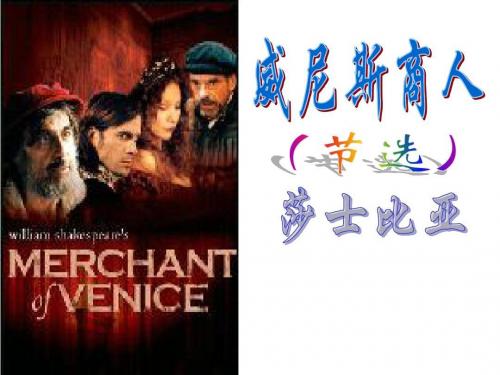
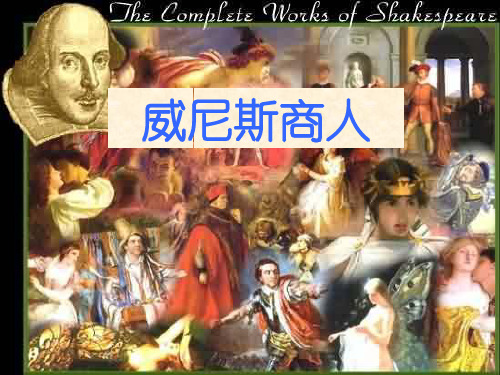
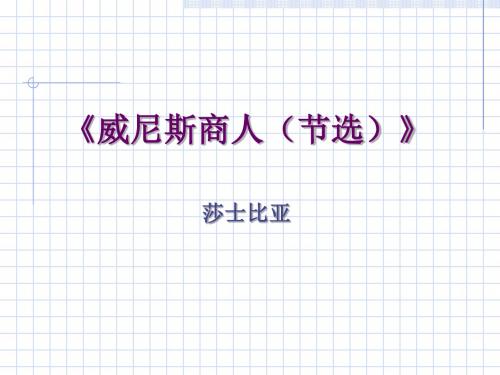
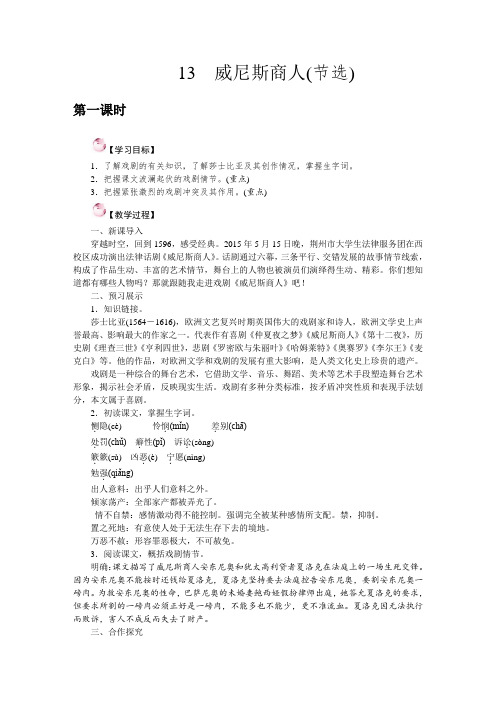
13威尼斯商人(节选)第一课时【学习目标】1.了解戏剧的有关知识,了解莎士比亚及其创作情况,掌握生字词。
2.把握课文波澜起伏的戏剧情节。
(重点)3.把握紧张激烈的戏剧冲突及其作用。
(重点)【教学过程】一、新课导入穿越时空,回到1596,感受经典。
2015年5月15日晚,荆州市大学生法律服务团在西校区成功演出法律话剧《威尼斯商人》。
话剧通过六幕,三条平行、交错发展的故事情节线索,构成了作品生动、丰富的艺术情节,舞台上的人物也被演员们演绎得生动、精彩。
你们想知道都有哪些人物吗?那就跟随我走进戏剧《威尼斯商人》吧!二、预习展示1.知识链接。
莎士比亚(1564-1616),欧洲文艺复兴时期英国伟大的戏剧家和诗人,欧洲文学史上声誉最高、影响最大的作家之一。
代表作有喜剧《仲夏夜之梦》《威尼斯商人》《第十二夜》,历史剧《理查三世》《亨利四世》,悲剧《罗密欧与朱丽叶》《哈姆莱特》《奥赛罗》《李尔王》《麦克白》等。
他的作品,对欧洲文学和戏剧的发展有重大影响,是人类文化史上珍贵的遗产。
戏剧是一种综合的舞台艺术,它借助文学、音乐、舞蹈、美术等艺术手段塑造舞台艺术形象,揭示社会矛盾,反映现实生活。
戏剧有多种分类标准,按矛盾冲突性质和表现手法划分,本文属于喜剧。
2.初读课文,掌握生字词。
恻.隐(cè)怜悯.(mǐn)差.别(chā)处.罚(chǔ) 癖.性(pǐ) 诉讼.(sòng)簌.簌(sù) 凶恶.(è) 宁.愿(nìng)勉强.(qiǎng)出人意料:出乎人们意料之外。
倾家荡产:全部家产都被弄光了。
情不自禁:感情激动得不能控制。
强调完全被某种感情所支配。
禁,抑制。
置之死地:有意使人处于无法生存下去的境地。
万恶不赦:形容罪恶极大,不可赦免。
3.阅读课文,概括戏剧情节。
明确:课文描写了威尼斯商人安东尼奥和犹太高利贷者夏洛克在法庭上的一场生死交锋。
因为安东尼奥不能按时还钱给夏洛克,夏洛克坚持要去法庭控告安东尼奥,要割安东尼奥一磅肉。

《威尼斯商人》优秀教案一、教学目标:1. 让学生了解莎士比亚及其作品《威尼斯商人》的历史背景。
2. 通过分析剧情,培养学生对反封建、反宗教禁欲主义的斗争精神的认识。
3. 引导学生深入理解夏洛克的邪恶本质,认识消灭封建势力的重要性。
4. 培养学生对人与人之间应注重友谊、仁爱、信任和宽容的人文主义思想。
二、教学重点与难点:1. 教学重点:(1)掌握作品的人物关系及故事情节。
(2)分析夏洛克这一典型人物形象,认识其邪恶本质。
(3)引导学生理解作品的主题思想。
2. 教学难点:(1)对夏洛克这一角色的深入分析。
(2)作品中所体现的人文主义思想。
三、教学方法:1. 采用讲授法,讲解作品背景、人物关系及故事情节。
2. 运用案例分析法,对夏洛克这一角色进行深入剖析。
3. 采用小组讨论法,引导学生探讨作品主题思想。
4. 利用情景模拟法,让学生体验作品中所体现的人文关怀。
四、教学准备:1. 教师准备:熟练掌握教材内容,了解学生实际情况。
2. 学生准备:预习教材,了解作品基本情节。
3. 教学资源:多媒体课件、教材、相关论文资料。
五、教学过程:1. 导入新课:简要介绍莎士比亚及其作品《威尼斯商人》,激发学生兴趣。
2. 讲授剧情:讲解故事情节,引导学生关注人物关系。
3. 分析夏洛克形象:深入剖析夏洛克的邪恶本质,引导学生认识消灭封建势力的重要性。
4. 探讨作品主题:引导学生理解作品中所体现的人文主义思想。
5. 课堂小结:总结本节课的学习内容,布置课后作业。
课后作业:1. 请学生结合课文内容,谈谈对夏洛克这一角色的认识。
2. 思考作品中所体现的人文主义思想,并结合现实生活举例说明。
3. 选取一个与《威尼斯商人》主题相关的名言警句,进行赏析。
六、教学拓展:1. 组织学生进行角色扮演,让学生亲身体验作品中的情景,进一步理解人物性格和作品主题。
2. 开展小组讨论,让学生从不同角度分析夏洛克这一角色的邪恶本质。
3. 邀请有关专家进行讲座,让学生更加深入地了解莎士比亚及其作品。
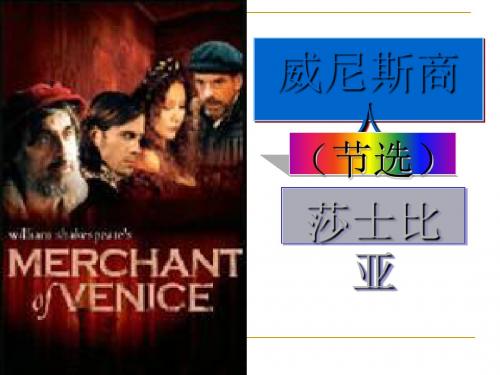
威尼斯商人鲍西娅,一个富人的女儿,按照她父亲的遗嘱,她得到了三个盒子:一个金盒子,一个银盒子,还有一个铅盒子。
其中一个盒子里面装着她的画像,如果哪个男人选择了正确的盒子,那么她将嫁给那个男人。
于是,求婚者从世界的四面八方云集到这儿,都希望能得到她……镇上有一个年轻人名叫巴萨尼奥,他下定决心要赢得鲍西娅。
但是,为了达到自己的愿望,他需要三千达克特——这可是一大笔钱。
于是,他向好友,富商安东尼奥求助,希望安东尼奥能借给他这笔钱。
然而,由于在海上投入的钱还没收回,安东尼奥手头上暂时也无法拿出这么多钱。
于是他被迫向另一个富有的犹太放债人——夏洛克借给他这笔钱。
安东尼奥和夏洛克都不喜欢对方:对于安东尼奥来说,他看不起放高利贷的,另一方面,他不喜欢夏洛克也因为他是犹太人;对于夏洛克来说,安东尼奥借钱给人从不收利息,这样就损害了他的利益。
尽管如此,在这种情况下,夏洛克还是同意借钱给安东尼奥,而且也不收他的利息;但是夏洛克提出了一个奇怪的要求:如果安东尼奥拖欠还款的话,他将会从安东尼奥身上割下一磅肉。
巴萨尼奥去了贝尔蒙特,他选择了正确的盒子——铅匣,也就是装有伊人肖像的匣子,也赢得了鲍西娅。
鲍西娅送给他一枚戒指,巴萨尼奥发誓永远把这枚戒指戴着。
与此同时,鲍西娅的女仆,娜瑞萨也接受了格拉夏诺的求婚,将自己的戒指也送给了他。
夏洛克的女儿,杰西卡同自己的爱人克里斯汀罗伦佐私奔了,并且偷走了她父亲的钱和珠宝。
而夏洛克也因为失去自己的女儿和钱财心情烦乱……当他得知安东尼奥在海上的投资全部丧失的消息之后,他决定向安东尼奥讨回借款。
在法庭上,夏洛克要求他和安东尼奥的合同能够履行。
鲍西娅和娜瑞萨假扮律师,为安东尼奥辩论,使得夏洛克的计划没有达成。
鲍西娅同意夏洛克按照契约规定割下安东尼奥的一磅肉,但是割这一磅肉必须严格按照契约执行,就是不能多割也不能少割,不能流一滴血,也不能因此伤害安东尼奥的性命。
夏洛克无法做到,只好认输。
这样,鲍西娅巧妙地挽救了安东尼奥的性命。
威尼斯商人第二幕第一场读后感A Deep Interpretation of Act 1 Scene 2 in The Merchant of VeniceThe Merchant of Venice is a very famous Shakespearean tragicomedy, and Act 1 Scene 2 is an important turning point in the play. This scene not only shows the complex relationships among the characters, but also reveals the multifaceted nature of human nature, especially when money, love, friendship, and morality collide.The scene is set in Venice, a bustling seaside city. The hustle and bustle of the streets form a stark contrast to the inner worlds of the characters. Antonio, the generous and kind-hearted merchant, chats with his friends Salarino and Salanio, revealing his melancholy mood. They try to explain his condition, blaming it on his cargo at sea. However, this is only a superficial reason. Antonio's melancholy actually stems from his deep-seated worries and anxieties, which are closely related to the impending conflicts and contradictions.The addition of Antonio's other three friends, Bassanio, Gratiano, and Lorenzo, further complicates the scene. Their arrival is not just to meet Antonio, but more importantly, to drive the plot forward. When Antonio asks Bassanio about the name of the lady he swore to visit in secret, Bassanio reveals information about Portia. This revelation presents us with an image of a beautiful woman with excellent moral character, and also foretells the emotional entanglements and conflicts that are about to ensue.Although Portia's name is mentioned in this scene and she herself does not appear, her presence has a profound impact on the plot. Her beauty and virtue become the focus of everyone's discussion, sparking desires and pursuits within Antonio and others. This pursuit is not just a longing for beauty, but also a desire for perfection and happiness.However, when money, love, friendship, and morality collide, people often make unexpected choices. In this scene, Antonio is willing to sign an apparently unfair contract with Shylock for the happiness of his friend Bassanio. This act not onlydemonstrates his profound friendship, but also reveals his views on money and morality. He is willing to sacrifice his own interests, even risk his life, for a friend. This kind of courage and determination is admirable.At the same time, Shylock's appearance as the antagonist in the play adds more drama and conflict to this scene. His hatred and jealousy towards Antonio become key factors driving the plot forward. When his daughter Jessica elopes with her lover Lorenzo, his anger and disappointment reach a peak. This not only escalates the contradictions and conflicts between him and Antonio, but also lays the groundwork for the subsequent plot.Overall, Act 1 Scene 2 of The Merchant of Venice is a scene full of drama and conflict. It showcases the complex relationships between characters and the multifaceted nature of human nature, especially when money, love, friendship, and morality collide. This scene not only lays the foundation for the subsequent plot, but also provides profound reflections on human nature and society.《威尼斯商人》第二幕第一场的深度解读《威尼斯商人》是莎士比亚非常著名的悲喜剧,而第二幕第一场则是该剧中一个重要的转折点。